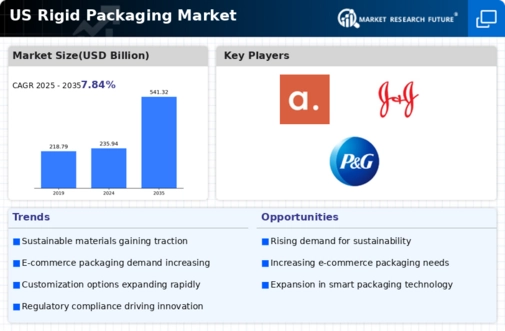Expansion of Retail Channels
The rigid packaging market is benefiting from the expansion of retail channels, particularly in the e-commerce sector. As online shopping continues to grow, the demand for packaging that can withstand shipping and handling is increasing. Rigid packaging solutions are favored for their ability to protect products during transit, ensuring that they arrive in optimal condition. Recent statistics indicate that e-commerce sales in the US have surged, with a projected growth rate of 15% annually. This trend compels manufacturers to adapt their packaging strategies to meet the needs of online retailers, thereby driving growth in the rigid packaging market.
Innovation in Packaging Materials
The rigid packaging market is being propelled by continuous innovation in packaging materials. Advances in technology have led to the development of new materials that offer enhanced durability, sustainability, and functionality. For example, the introduction of biodegradable plastics and lightweight composites is transforming the landscape of rigid packaging. These innovations not only meet consumer demands for eco-friendly options but also provide manufacturers with opportunities to reduce costs and improve efficiency. As the market evolves, the adoption of innovative materials is likely to play a pivotal role in shaping the future of the rigid packaging market.
Rise of Health-Conscious Consumers
The rigid packaging market is witnessing a surge in demand driven by the rise of health-conscious consumers. As individuals become more aware of their dietary choices, there is a growing preference for products that are perceived as healthier and more natural. This trend is particularly pronounced in the food and beverage sector, where packaging plays a crucial role in conveying product attributes. Approximately 70% of consumers in the US report that they consider packaging information when making food choices. Consequently, manufacturers are increasingly utilizing rigid packaging to highlight health benefits, nutritional information, and ingredient transparency, thereby enhancing the appeal of their products in the rigid packaging market.
Consumer Preference for Convenience
The rigid packaging market is experiencing a notable shift as consumers increasingly favor convenience in their purchasing decisions. This trend is particularly evident in sectors such as food and beverages, where ready-to-eat meals and single-serve packaging are gaining traction. According to recent data, approximately 60% of consumers in the US prioritize convenience when selecting packaged products. This preference drives manufacturers to innovate and design packaging solutions that enhance usability, such as easy-open features and resealable options. As a result, the demand for rigid packaging solutions that cater to these consumer needs is likely to rise, further propelling growth in the rigid packaging market.
Regulatory Compliance and Safety Standards
The rigid packaging market is significantly influenced by stringent regulatory compliance and safety standards imposed by government agencies. In the US, regulations regarding food safety, environmental impact, and material safety are becoming increasingly rigorous. For instance, the Food and Drug Administration (FDA) mandates specific guidelines for packaging materials used in food products. This regulatory landscape compels manufacturers to invest in high-quality materials and processes that meet these standards, thereby driving demand for advanced rigid packaging solutions. As companies strive to ensure compliance, the market for rigid packaging is expected to expand, with an emphasis on safety and sustainability.














Leave a Comment